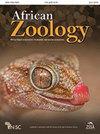研究高盐度对侵袭性腹足类黑素结核动物心脏功能的影响(m ller, 1774)
IF 0.5
4区 生物学
Q4 ZOOLOGY
引用次数: 0
摘要
人为活动推动了对自然环境的开发,这与气候变化一起导致了全球淡水生态系统的盐度入侵。为了确定高盐度应激源对淡水生态系统的影响程度,分析了淡水腹足类结核黑腹蛛在急性暴露于不同盐度浓度期间的生理心脏反应。采用非侵入性方法监测生物体的心脏活动。结核分枝杆菌的平均心率(bpm)在20 ppt至30 ppt之间显著下降。结核黑色素瘤表现出25 ppt的高盐度阈值和高达50 ppt的耐受盐度浓度。所收集的数据为结核分枝杆菌作为生物指示生物的使用提供了背景数据,以评估高盐度对淡水生态系统中生物心脏反应的影响。本文章由计算机程序翻译,如有差异,请以英文原文为准。
Investigating the Effects of Hypersalinity on the Cardiac Performance of the Invasive Gastropod Melanoides tuberculata (Müller, 1774)
Anthropogenic activities have propelled the exploitation of natural environments, which along with climate change have resulted in salinity intrusion to freshwater ecosystems worldwide. To determine the extent the hypersalinity stressor has on freshwater ecosystems, physiological cardiac responses in the freshwater gastropod Melanoides tuberculata were analysed during an acute exposure to varying salinity concentrations. A non-invasive method was used to monitor the cardiac activity of the organisms. The mean heart rate (bpm) of M. tuberculata declined significantly between 20 ppt and 30 ppt. Melanoides tuberculata exhibited a hypersalinity threshold of 25 ppt and tolerated salinity concentrations up to 50 ppt. Data collected provide background data for the use of M. tuberculata as a bioindicator organism to assess the effects of hypersalinity on cardiac response of organisms in a freshwater ecosystem.
求助全文
通过发布文献求助,成功后即可免费获取论文全文。
去求助
来源期刊

African Zoology
生物-动物学
CiteScore
2.60
自引率
9.10%
发文量
18
审稿时长
>12 weeks
期刊介绍:
African Zoology , a peer-reviewed research journal, publishes original scientific contributions and critical reviews that focus principally on African fauna in terrestrial, freshwater, and marine ecosystems. Research from other regions that advances practical and theoretical aspects of zoology will be considered. Rigorous question-driven research in all aspects of zoology will take precedence over descriptive research. The Journal publishes full-length papers, critical reviews, short communications, letters to the editors as well as book reviews. Contributions based on purely observational, descriptive or anecdotal data will not be considered.
The Journal is produced by NISC in association with the Zoological Society of South Africa (ZSSA). Acceptance of papers is the responsibility of the Editors-in-Chief in consultation with the Editors and members of the Editorial Advisory Board. All views expressed are those of the author and not necessarily those of the Editors or the Department.
 求助内容:
求助内容: 应助结果提醒方式:
应助结果提醒方式:


